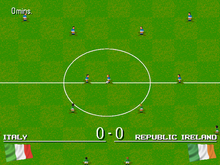Football simulation
Football simulation refers to a genre of video or computer games that tries to reproduce the sport of football as accurately as possible. A basic distinction can be made between football games in which the player controls the players on the pitch and football manager simulations in which he takes on the role of a club manager. Today the genre is mainly dominated by the game series FIFA and Pro Evolution Soccer .
history

Football simulations are almost as old as computer games themselves. As early as 1972, a football game was published on the Magnavox Odyssey platform. Early on, the genre split into actual soccer games and soccer managers . Due to the technical limitations of the graphics performance, the pure football managers were initially more successful, as their representations could withdraw to abstract texts and representations. However, with increasing hardware performance, the focus shifted in the longer term in favor of game simulations. Titles like Kick Off or Sensible Soccer ultimately made the genre even more popular.
The game mechanics of the first games differ only slightly from the principle of kick and rush , which allowed only a few maneuvers and tactical options for action during the game. However, later games were increasingly measured by their authenticity and the recognizability of real football.
In the early stages of the genre, soccer games were mainly shown from a bird's eye view . Other approaches used the isometric perspective with an oblique view of the field. Today, the games are mainly presented from the side of the field, as in a television broadcast, with occasional action cameras for special events.
In the early days, the player names and integrated teams were based on fantasy, but the developers quickly switched to mapping the real compositions of the teams and football leagues. More recent games are increasingly measured by their relevance to reality. Modern game titles, such as the FIFA series, therefore now rely on numerous licenses from the individual football leagues and associations based on player and team names as standard.
Game content
At the start of a soccer game, the player selects two teams to compete against each other. Contrary to reality, the same team or national teams can compete against club teams twice . The player then chooses which of the two teams should be controlled by the player and which by the artificial intelligence of the computer. In general, multiple human players can join either side.
After selecting the sides, the player can choose from the tactical line-up, the game system, behavior in standard situations and other settings. These settings can often be left as they are or adopted by the computer. In games of PES - range beyond the daily condition of a player decides about his possible line-up. Each player has individual skills that largely correspond to the actual skills of the real player. In addition, there are special skills, such as special dribbling skills for particularly talented players. After the team line-up, the game begins.
Nowadays, the game is commented on by voice output. The voice output consists of combined voice samples that were often recorded by well-known football commentators in the studio. The speech samples are played depending on the situation. In addition to the usual phrases, the majority of the participating soccer players are named when they have the ball in order to create a greater reference to a real soccer broadcast.
If the player competes alone against the computer or another human player, he controls all the players on his team. He controls the player in charge of the ball. If the activated soccer player matches another player, he will be activated. If the opponent is in possession of the ball, the player can freely choose between the players on his team and thus attack the opponent in order to gain possession of the ball.
The rules of the game of football simulation are based on the rules of the world football association FIFA and the national associations. Particularly gross fouls, for example, are punished here just as they are in reality. The user is free to choose the game time. The actual 90 minutes are typically reduced to six to 15 minutes in the game. The time on the simulated stadium display runs in time lapse. In a normal friendly game , stoppage time, the golden goal or the penalty shoot-out decide the winner of a game. Ties are also possible. After the end of the game, you have the option of playing the game again (revenge).
Some elements of real football are not shown for various reasons. Today it is no longer possible to attack the goalkeeper with the goal kick or the player with the throw-in, as this would in reality lead directly to a red card. Swallows are also not possible in all simulations, but are penalized if they occur. Injuries can mean that the playing figure cannot continue the game and has to be replaced.
variants
In addition to the individual game (friendly game), numerous variants such as tournaments, career modes or online games are offered. These offers are modifications of a single game and combine the game into a coherent series of events with ongoing injuries, obligations of players and promotion and relegation.
With the Fantasy Football variant , the game result is based on the real course of the game of real clubs.
Web links
- Football simulation at MobyGames (English)
- A History Of The Beautiful Game. In: Retro Gamer . August 20, 2010, archived from the original on March 16, 2012 .
Individual evidence
- ↑ Retro Game Kult- 1958–1989: Line graphics and realism- The classics of… - Christian Wirsig - Google books . Retrieved January 14, 2012.
- ↑ MobyGames: Game Browser . Retrieved January 14, 2012.